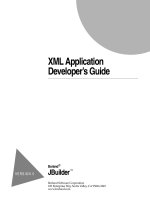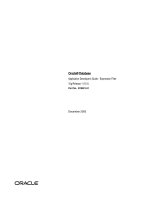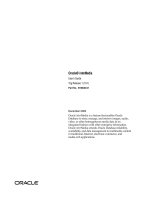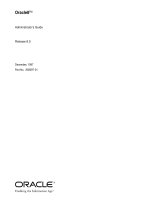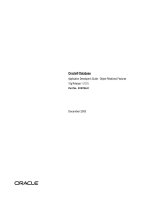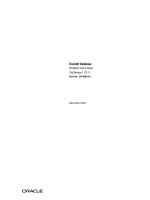Tài liệu Application Developer''''s Guide docx
Bạn đang xem bản rút gọn của tài liệu. Xem và tải ngay bản đầy đủ của tài liệu tại đây (2.85 MB, 252 trang )
Oracle® Text
Application Developer's Guide
10g Release 1 (10.1)
Part No. B10729-01
December 2003
Oracle Text Application Developer's Guide, 10g Release 1 (10.1)
Part No. B10729-01
Copyright © 2003 Oracle Corporation. All rights reserved.
Primary Author: Colin McGregor
Contributors: Omar Alonso, Shamim Alpha, Steve Buxton, Chung-Ho Chen, Jack Chen, Yun Cheng,
Michele Cyran, Paul Dixon, Mohammad Faisal, Roger Ford, Elena Huang, Garrett Kaminaga, Ji Sun
Kang, Ciya Liao, Wesley Lin, Bryn Llewellyn, Yasuhiro Matsuda, Valarie Moore, Takeshi Okawa, Gerda
Shank, Qunong Xiao, Steve Yang
The Programs (which include both the software and documentation) contain proprietary information of
Oracle Corporation; they are provided under a license agreement containing restrictions on use and
disclosure and are also protected by copyright, patent and other intellectual and industrial property
laws. Reverse engineering, disassembly or decompilation of the Programs, except to the extent required
to obtain interoperability with other independently created software or as specified by law, is prohibited.
The information contained in this document is subject to change without notice. If you find any problems
in the documentation, please report them to us in writing. Oracle Corporation does not warrant that this
document is error-free. Except as may be expressly permitted in your license agreement for these
Programs, no part of these Programs may be reproduced or transmitted in any form or by any means,
electronic or mechanical, for any purpose, without the express written permission of Oracle Corporation.
If the Programs are delivered to the U.S. Government or anyone licensing or using the programs on
behalf of the U.S. Government, the following notice is applicable:
Restricted Rights Notice Programs delivered subject to the DOD FAR Supplement are "commercial
computer software" and use, duplication, and disclosure of the Programs, including documentation,
shall be subject to the licensing restrictions set forth in the applicable Oracle license agreement.
Otherwise, Programs delivered subject to the Federal Acquisition Regulations are "restricted computer
software" and use, duplication, and disclosure of the Programs shall be subject to the restrictions in FAR
52.227-19, Commercial Computer Software - Restricted Rights (June, 1987). Oracle Corporation, 500
Oracle Parkway, Redwood City, CA 94065.
The Programs are not intended for use in any nuclear, aviation, mass transit, medical, or other inherently
dangerous applications. It shall be the licensee's responsibility to take all appropriate fail-safe, backup,
redundancy, and other measures to ensure the safe use of such applications if the Programs are used for
such purposes, and Oracle Corporation disclaims liability for any damages caused by such use of the
Programs.
Oracle is a registered trademark, and Gist, Oracle Store, Oracle9i, PL/SQL, and SQL*Plus are trademarks
or registered trademarks of Oracle Corporation. Other names may be trademarks of their respective
owners.
iii
Contents
Send Us Your Comments xv
Preface xvii
Audience xvii
Organization xvii
Related Documentation xix
Conventions xx
Documentation Accessibility xxii
1 Oracle Text Application Development
What is Oracle Text? 1-1
Designing Your Application 1-1
Text Queries on Document Collections 1-2
Flowchart of Text Query Application 1-2
Queries on Catalog Information 1-4
Flowchart for Catalog Query Application 1-5
Document Classification 1-6
XML Searching 1-7
Using Oracle Text 1-8
Using the Oracle XML DB Framework 1-8
Combining Oracle Text features with Oracle XML DB 1-9
Using the Text-on-XML Method 1-9
Using the XML-on-Text Method 1-10
iv
2 Getting Started with Oracle Text
Overview of Getting Started with Oracle Text 2-1
Creating an Oracle Text User 2-1
Query Application Quick Tour 2-2
Building Web Applications with the Oracle Text Wizard 2-6
Oracle JDeveloper 2-6
Oracle Text Wizard Addins 2-6
Oracle Text Wizard Instructions 2-6
Catalog Application Quick Tour 2-7
Classification Application Quick Tour 2-10
Steps for Creating a Classification Application 2-11
3 Indexing
About Oracle Text Indexes 3-1
Type of Index 3-1
Structure of the Oracle Text CONTEXT Index 3-5
Merged Word and Theme Index 3-5
The Oracle Text Indexing Process 3-5
Datastore Object 3-6
Filter Object 3-6
Sectioner Object 3-7
Lexer Object 3-7
Indexing Engine 3-7
Partitioned Tables and Indexes 3-7
Querying Partitioned Tables 3-8
Creating an Index Online 3-8
Parallel Indexing 3-8
Indexing and Views 3-9
Considerations For Indexing 3-9
Location of Text 3-10
Supported Column Types 3-12
Storing Text in the Text Table 3-12
Storing File Path Names 3-12
Storing URLs 3-13
Storing Associated Document Information 3-13
v
Format and Character Set Columns 3-13
Supported Document Formats 3-13
Summary of DATASTORE Types 3-14
Document Formats and Filtering 3-14
No Filtering for HTML 3-15
Filtering Mixed-Format Columns 3-15
Custom Filtering 3-15
Bypassing Rows for Indexing 3-15
Document Character Set 3-16
Mixed Character Set Columns 3-16
Document Language 3-16
Languages Features Outside BASIC_LEXER 3-16
Indexing Multi-language Columns 3-17
Indexing Special Characters 3-17
Printjoins Character 3-17
Skipjoins Character 3-17
Other Characters 3-18
Case-Sensitive Indexing and Querying 3-18
Language Specific Features 3-18
Indexing Themes 3-18
Base-Letter Conversion for Characters with Diacritical Marks 3-19
Alternate Spelling 3-19
Composite Words 3-19
Korean, Japanese, and Chinese Indexing 3-20
Fuzzy Matching and Stemming 3-20
Better Wildcard Query Performance 3-21
Document Section Searching 3-21
Stopwords and Stopthemes 3-21
Multi-Language Stoplists 3-22
Index Performance 3-22
Query Performance and Storage of LOB Columns 3-22
Index Creation 3-22
Procedure for Creating a CONTEXT Index 3-23
Creating Preferences 3-24
Datastore Examples 3-24
vi
NULL_FILTER Example: Indexing HTML Documents 3-25
PROCEDURE_FILTER Example 3-25
BASIC_LEXER Example: Setting Printjoins Characters 3-26
MULTI_LEXER Example: Indexing a Multi-Language Table 3-26
BASIC_WORDLIST Example: Enabling Substring and Prefix Indexing 3-27
Creating Section Groups for Section Searching 3-28
Example: Creating HTML Sections 3-28
Using Stopwords and Stoplists 3-28
Multi-Language Stoplists 3-29
Stopthemes and Stopclasses 3-29
PL/SQL Procedures for Managing Stoplists 3-29
Creating an Index 3-30
Creating a CONTEXT Index 3-30
CONTEXT Index and DML 3-30
Default CONTEXT Index Example 3-30
Custom CONTEXT Index Example: Indexing HTML Documents 3-31
Creating a CTXCAT Index 3-32
CTXCAT Index and DML 3-32
About CTXCAT Sub-Indexes and Their Costs 3-32
Creating CTXCAT Sub-indexes 3-33
Creating CTXCAT Index 3-35
Creating a CTXRULE Index 3-35
Create a Table of Queries 3-35
Create the CTXRULE Index 3-36
Classifying a Document 3-36
Index Maintenance 3-37
Viewing Index Errors 3-37
Dropping an Index 3-37
Resuming Failed Index 3-38
Example: Resuming a Failed Index 3-38
Rebuilding an Index 3-38
Example: Rebuilding and Index 3-39
Dropping a Preference 3-39
Example 3-39
Managing DML Operations for a CONTEXT Index 3-39
vii
Viewing Pending DML 3-39
Synchronizing the Index 3-40
Setting Background DML 3-40
Index Optimization 3-41
CONTEXT Index Structure 3-41
Index Fragmentation 3-41
Document Invalidation and Garbage Collection 3-41
Single Token Optimization 3-42
Viewing Index Fragmentation and Garbage Data 3-42
Examples: Optimizing the Index 3-42
4 Querying
Overview of Queries 4-1
Querying with CONTAINS 4-1
CONTAINS SQL Example 4-2
CONTAINS PL/SQL Example 4-2
Structured Query with CONTAINS 4-3
Querying with CATSEARCH 4-3
CATSEARCH SQL Query 4-4
CATSEARCH Example 4-4
Querying with MATCHES 4-6
MATCHES SQL Query 4-6
MATCHES PL/SQL Example 4-8
Word and Phrase Queries 4-10
CONTAINS Phrase Queries 4-10
CATSEARCH Phrase Queries 4-10
Querying Stopwords 4-10
ABOUT Queries and Themes 4-11
Querying Stopthemes 4-11
Query Expressions 4-12
CONTAINS Operators 4-12
CATSEARCH Operator 4-12
MATCHES Operator 4-13
Case-Sensitive Searching 4-13
Word Queries 4-13
viii
ABOUT Queries 4-13
Query Feedback 4-14
Query Explain Plan 4-14
Using a Thesaurus in Queries 4-14
Document Section Searching 4-15
Using Query Templating 4-15
Query Rewrite 4-16
Query Relaxation 4-16
Query Language 4-17
Alternative Scoring 4-18
Alternative Grammar 4-18
Query Analysis 4-18
Other Query Features 4-19
The CONTEXT Grammar 4-20
ABOUT Query 4-21
Logical Operators 4-21
Section Searching 4-22
Proximity Queries with NEAR and NEAR_ACCUM Operators 4-22
Fuzzy, Stem, Soundex, Wildcard and Thesaurus Expansion Operators 4-23
Using CTXCAT Grammar 4-23
Stored Query Expressions 4-23
Defining a Stored Query Expression 4-24
SQE Example 4-24
Calling PL/SQL Functions in CONTAINS 4-25
Optimizing for Response Time 4-25
Other Factors that Influence Query Response Time 4-25
Counting Hits 4-26
SQL Count Hits Example 4-26
Counting Hits with a Structured Predicate 4-26
PL/SQL Count Hits Example 4-27
The CTXCAT Grammar 4-27
Using CONTEXT Grammar with CATSEARCH 4-28
5 Document Presentation
Highlighting Query Terms 5-1
ix
Text highlighting 5-1
Theme Highlighting 5-1
CTX_DOC Highlighting Procedures 5-2
Highlight Procedure 5-2
Markup Procedure 5-2
Filter Procedure 5-4
CTX_DOC.POLICY_FILTER Procedure 5-4
Obtaining Lists of Themes, Gists, and Theme Summaries 5-4
Lists of Themes 5-5
In-Memory Themes 5-5
Result Table Themes 5-5
Gist and Theme Summary 5-6
In-Memory Gist 5-6
Result Table Gists 5-6
Theme Summary 5-7
Document Presentation and Highlighting 5-7
Highlighting Example 5-9
Document List of Themes Example 5-10
Gist Example 5-11
6 Document Classification
Overview 6-1
Classification Applications 6-2
Classification Solutions 6-3
Rule-Based Classification 6-4
Rule-based Classification Example 6-4
CTXRULE Parameters and Limitations 6-8
Supervised Classification 6-8
Decision Tree Supervised Classification 6-9
Decision Tree Supervised Classification Example 6-10
SVM-Based Supervised Classification 6-13
SVM-Based Supervised Classification Example 6-14
Unsupervised Classification (Clustering) 6-16
Clustering Example 6-17
x
7 Performance Tuning
Optimizing Queries with Statistics 7-1
Collecting Statistics 7-2
Example 7-3
Re-Collecting Statistics 7-4
Deleting Statistics 7-4
Optimizing Queries for Response Time 7-4
Other Factors that Influence Query Response Time 7-5
Improved Response Time with FIRST_ROWS(n) for ORDER BY Queries 7-5
About the FIRST_ROWS Hint 7-6
Improved Response Time using Local Partitioned CONTEXT Index 7-7
Range Search on Partition Key Column 7-7
ORDER BY Partition Key Column 7-7
Improved Response Time with Local Partitioned Index for Order by Score 7-8
Optimizing Queries for Throughput 7-9
CHOOSE and ALL ROWS Modes 7-9
FIRST_ROWS Mode 7-9
Tracing 7-9
Parallel Queries 7-10
Tuning Queries with Blocking Operations 7-11
Frequently Asked Questions a About Query Performance 7-12
What is Query Performance? 7-12
What is the fastest type of text query? 7-12
Should I collect statistics on my tables? 7-13
How does the size of my data affect queries? 7-13
How does the format of my data affect queries? 7-13
What is a functional versus an indexed lookup? 7-13
What tables are involved in queries? 7-14
Does sorting the results slow a text-only query? 7-14
How do I make a ORDER BY score query faster? 7-14
Which Memory Settings Affect Querying? 7-15
Does out of line LOB storage of wide base table columns improve performance? 7-15
How can I make a CONTAINS query on more than one column faster? 7-15
Is it OK to have many expansions in a query? 7-16
How can local partition indexes help? 7-17
xi
Should I query in parallel? 7-18
Should I index themes? 7-18
When should I use a CTXCAT index? 7-18
When is a CTXCAT index NOT suitable? 7-19
What optimizer hints are available, and what do they do? 7-19
Frequently Asked Questions About Indexing Performance 7-19
How long should indexing take? 7-19
Which index memory settings should I use? 7-20
How much disk overhead will indexing require? 7-21
How does the format of my data affect indexing? 7-21
Can parallel indexing improve performance? 7-21
How can I improve index performance for creating local partitioned index? 7-22
How can I tell how much indexing has completed? 7-23
Frequently Asked Questions About Updating the Index 7-23
How often should I index new or updated records? 7-23
How can I tell when my indexes are getting fragmented? 7-23
Does memory allocation affect index synchronization? 7-24
8 Document Section Searching
About Document Section Searching 8-1
Enabling Section Searching 8-1
Create a Section Group 8-2
Define Your Sections 8-4
Index your Documents 8-4
Section Searching with WITHIN Operator 8-4
Path Searching with INPATH and HASPATH Operators 8-4
Section Types 8-5
Zone Section 8-5
Field Section 8-7
Stop Section 8-9
MDATA Section 8-9
Attribute Section 8-12
Special Sections 8-12
HTML Section Searching 8-13
Creating HTML Sections 8-13
xii
Searching HTML Meta Tags 8-14
Example: Creating Sections for <META>Tags 8-14
XML Section Searching 8-14
Automatic Sectioning 8-14
Attribute Searching 8-15
Creating Attribute Sections 8-15
Searching Attributes with the INPATH Operator 8-16
Creating Document Type Sensitive Sections 8-16
Path Section Searching 8-16
Creating Index with PATH_SECTION_GROUP 8-17
Top-Level Tag Searching 8-17
Any-Level Tag Searching 8-18
Direct Parentage Searching 8-18
Tag Value Testing 8-18
Attribute Searching 8-18
Attribute Value Testing 8-19
Path Testing 8-19
Section Equality Testing with HASPATH 8-19
9 Working With a Thesaurus
Overview of Thesauri 9-1
Thesaurus Creation and Maintenance 9-1
CTX_THES Package 9-2
Thesaurus Operators 9-2
ctxload Utility 9-2
Case-sensitive Thesauri 9-2
Case-insensitive Thesauri 9-3
Default Thesaurus 9-3
Supplied Thesaurus 9-4
Supplied Thesaurus Structure and Content 9-4
Supplied Thesaurus Location 9-4
Defining Thesaural Terms 9-4
Defining Synonyms 9-5
Defining Hierarchical Relations 9-5
Using a Thesaurus in a Query Application 9-6
xiii
Loading a Custom Thesaurus and Issuing Thesaural Queries 9-6
Advantage 9-6
Limitations 9-6
Augmenting Knowledge Base with Custom Thesaurus 9-7
Advantage 9-7
Limitations 9-7
Linking New Terms to Existing Terms 9-8
Loading a Thesaurus with ctxload 9-8
Compiling a Loaded Thesaurus 9-9
About the Supplied Knowledge Base 9-9
Adding a Language-Specific Knowledge Base 9-10
Limitations 9-10
10 Administration
Oracle Text Users and Roles 10-1
CTXSYS User 10-1
CTXAPP Role 10-2
Granting Roles and Privileges to Users 10-2
DML Queue 10-2
The CTX_OUTPUT Package 10-3
The CTX_REPORT Package 10-3
Servers 10-7
Administration Tool 10-7
11 Migrating Applications from Earlier Releases
Security Improvements in Oracle Text 11-1
CTXSYS No Longer Has DBA Permissions 11-1
Migrating CTXSYS-Owned Procedures 11-2
Effective User During Indexing 11-2
Procedures Do Not Need to Be Owned by CTXSYS 11-3
Synching and Optimizing of Other Users' Indexes 11-3
CTX Packages and Invoker's Rights 11-3
CREATE TABLE Permissions 11-3
Migrating Back to Previous Releases 11-4
xiv
A CONTEXT Query Application
Web Query Application Overview A-1
The PSP Web Application A-4
Web Application Prerequisites A-4
Building the Web Application A-4
PSP Sample Code A-6
loader.ctl A-6
loader.dat A-7
search_htmlservices.sql A-7
search_html.psp A-9
The JSP Web Application A-11
Web Application Prerequisites A-11
JSP Sample Code A-12
search_html.jsp A-12
B CATSEARCH Query Application
CATSEARCH Web Query Application Overview B-1
The JSP Web Application B-1
Building the JSP Web Application B-2
JSP Sample Code B-4
loader.ctl B-5
loader.dat B-5
catalogSearch.jsp B-5
Index
xv
Send Us Your Comments
Oracle Text Application Developer’s Guide, 10g Release 1 (10.1)
Part No. B10729-01
Oracle Corporation welcomes your comments and suggestions on the quality and usefulness of this
publication. Your input is an important part of the information used for revision.
■ Did you find any errors?
■ Is the information clearly presented?
■ Do you need more information? If so, where?
■ Are the examples correct? Do you need more examples?
■ What features did you like most about this manual?
If you find any errors or have any other suggestions for improvement, please indicate the title and
part number of the documentation and the chapter, section, and page number (if available). You can
send comments to us in the following ways:
■ Electronic mail:
■ FAX: (650) 506-7227. Attn: Server Technologies Documentation
■ Postal service:
Oracle Corporation
Server Technologies Documentation
500 Oracle Parkway, Mailstop 4op11
Redwood Shores, CA 94065
USA
If you would like a reply, please give your name, address, telephone number, and electronic mail
address (optional).
If you have problems with the software, please contact your local Oracle Support Services.
xvi
xvii
Preface
This guide explains how to build query applications with Oracle Text. This preface
contains these topics:
■ Audience
■ Organization
■ Related Documentation
■ Conventions
■ Documentation Accessibility
Audience
Oracle Text Application Developer’s Guide is intended for users who perform the
following tasks:
■ Develop Oracle Text applications
■ Administer Oracle Text installations
To use this document, you need to have experience with the Oracle object relational
database management system, SQL, SQL*Plus, and PL/SQL.
Organization
This document contains:
xviii
Chapter 1, "Oracle Text Application Development"
This chapter explains the basic features of the query, catalog, and classification
applications that you can build with Oracle Text.
Chapter 2, "Getting Started with Oracle Text"
This chapter explains how to get started on building a simple query applications
using Oracle Text.
Chapter 3, "Indexing"
This chapter describes how to index your document set. It discusses considerations
for indexing as well as how to create CONTEXT, CTXCAT, and CTXRULE indexes.
Chapter 4, "Querying"
This chapter describes how to query your document set. It gives examples for how
to use the CONTAINS, CATSEARCH, and MATCHES operators.
Chapter 5, "Document Presentation"
This chapter describes how to present documents to the user of your query
application.
Chapter 6, "Document Classification"
This chapter describes how to build classification applications.
Chapter 7, "Performance Tuning"
This chapter describes how to tune your queries to improve response time and
throughput.
Chapter 8, "Document Section Searching"
This chapter describes how to enable section searching in HTML and XML.
Chapter 9, "Working With a Thesaurus"
This chapter describes how to work with a thesaurus in your application. It also
describes how to augment your knowledge base with a thesaurus.
Chapter 10, "Administration"
This chapter describes Oracle Text administration.
xix
Chapter 11, "Migrating Applications from Earlier Releases"
This chapter describes how to migrate your applications from earlier versions of
Oracle Text.
Appendix A, "CONTEXT Query Application"
This appendix describes a sample Oracle Text CONTEXT Web application and the
wizard used to produce it.
Appendix B, "CATSEARCH Query Application"
This appendix describes an Oracle Text CATSEARCH example Web application.
Related Documentation
For more information about Oracle Text, refer to:
■ Oracle Text Reference
For more information about Oracle Database, refer to:
■ Oracle Database Concepts
■ Oracle Database Administrator's Guide
■ Oracle Database Utilities
■ Oracle Database Performance Tuning Guide
■ Oracle Database SQL Reference
■ Oracle Database Reference
■ Oracle Database Application Developer's Guide - Fundamentals
For more information about PL/SQL, refer to:
■ PL/SQL User's Guide and Reference
You can obtain Oracle Text technical information, collateral, code samples, training
slides and other material at:
/>Many books in the documentation set use the sample schemas of the seed database,
which is installed by default when you install Oracle Database. Refer to Oracle
Database Sample Schemas for information on how these schemas were created and
how you can use them yourself.
xx
Printed documentation is available for sale in the Oracle Store at
/>To download free release notes, installation documentation, white papers, or other
collateral, please visit the Oracle Technology Network (OTN). You must register
online before using OTN; registration is free and can be done at
/>If you already have a username and password for OTN, then you can go directly to
the documentation section of the OTN Web site at
/>Conventions
This section describes the conventions used in the text and code examples of the
this documentation set. It describes:
■ Conventions in Text
■ Conventions in Code Examples
Conventions in Text
We use various conventions in text to help you more quickly identify special terms.
The following table describes those conventions and provides examples of their use.
Convention Meaning Example
Bold Bold typeface indicates terms that are
defined in the text or terms that appear in
a glossary, or both.
The C datatypes such as ub4, sword, or
OCINumber are valid.
When you specify this clause, you create an
index-organized table.
Italics Italic typeface indicatesquery terms, book
titles, emphasis, syntax clauses, or
placeholders.
Oracle9i Concepts
You can specify the parallel_clause.
Run Uold_release.SQL where old_release
refers to the release you installed prior to
upgrading.
xxi
Conventions in Code Examples
Code examples illustrate SQL, PL/SQL, SQL*Plus, or other command-line
statements. They are displayed in a monospace (fixed-width) font and separated
from normal text as shown in this example:
SELECT username FROM dba_users WHERE username = 'MIGRATE';
The following table describes typographic conventions used in code examples and
provides examples of their use.
UPPERCASE
monospace
(fixed-width font)
Uppercase monospace typeface indicates
elements supplied by the system. Such
elements include parameters, privileges,
datatypes, RMAN keywords, SQL
keywords,SQL*Plus or utilitycommands,
packages and methods, as well as
system-supplied column names, database
objects and structures, user names, and
roles.
You can specify this clause only for a NUMBER
column.
You can back up the database using the BACKUP
command.
Query the TABLE_NAME column in the USER_
TABLES table in the data dictionary view.
Specify the ROLLBACK_SEGMENTS parameter.
Use the DBMS_STATS.GENERATE_STATS
procedure.
lowercase
monospace
(fixed-width font)
Lowercase monospace typeface indicates
executables and sample user-supplied
elements. Such elements include
computer and database names, net
service names, and connect identifiers, as
well as user-supplied database objects
and structures, column names, packages
and classes, user names and roles,
program units, and parameter values.
Enter sqlplus to open SQL*Plus.
The department_id, department_name,
and location_id columns are in the
hr.departments table.
Set the QUERY_REWRITE_ENABLED
initialization parameter to true.
Connect as oe user.
Convention Meaning Example
[ ] Brackets enclose one or more optional
items. Do not enter the brackets.
DECIMAL (digits [ , precision ])
{ } Braces enclose two or more items, one of
which is required. Do not enter the
braces.
{ENABLE | DISABLE}
| A vertical bar represents a choice of two
or more options within brackets or braces.
Enter one of the options. Do not enter the
vertical bar.
{ENABLE | DISABLE}
[COMPRESS | NOCOMPRESS]
Convention Meaning Example
xxii
Documentation Accessibility
Our goal is to make Oracle products, services, and supporting documentation
accessible, with good usability, to the disabled community. To that end, our
documentation includes features that make information available to users of
assistive technology. This documentation is available in HTML format, and contains
markup to facilitate access by the disabled community. Standards will continue to
evolve over time, and Oracle is actively engaged with other market-leading
technology vendors to address technical obstacles so that our documentation can be
accessible to all of our customers. For additional information, visit the Oracle
Accessibility Program Web site at
Horizontal ellipsis points indicate either:
That we have omitted parts of the code
that are not directly related to the
example
That you can repeat a portion of the code
CREATE TABLE AS subquery;
SELECT col1, col2, , coln FROM
employees;
.
.
.
Vertical ellipsis points indicate that we
have omitted several lines of code not
directly related to the example.
Other notation You must enter symbols other than
brackets, braces, vertical bars, and ellipsis
points as it is shown.
acctbal NUMBER(11,2);
acct CONSTANT NUMBER(4) := 3;
Italics Italicized text indicates variables for
which you must supply particular values.
CONNECT SYSTEM/system_password
UPPERCASE Uppercase typeface indicates elements
supplied by the system. We show these
terms in uppercase in order to distinguish
them from terms you define. Unless terms
appear in brackets, enter them in the
order and with the spelling shown.
However, because these terms are not
case sensitive, you can enter them in
lowercase.
SELECT last_name, employee_id FROM
employees;
SELECT * FROM USER_TABLES;
DROP TABLE hr.employees;
lowercase Lowercase typeface indicates
programmatic elements that you supply.
For example, lowercase indicates names
of tables, columns, or files.
SELECT last_name, employee_id FROM
employees;
sqlplus hr/hr
Convention Meaning Example
xxiii
/>Accessibility of Code Examples in Documentation JAWS, a Windows screen
reader, may not always correctly read the code examples in this document. The
conventions for writing code require that closing braces should appear on an
otherwise empty line; however, JAWS may not always read a line of text that
consists solely of a bracket or brace.
xxiv
Oracle Text Application Development 1-1
1
Oracle Text Application Development
This chapter discuses the following topics:
■ What is Oracle Text?
■ Designing Your Application
■ Text Queries on Document Collections
■ Queries on Catalog Information
■ Document Classification
■ XML Searching
What is Oracle Text?
Oracle Text is a technology that enables you to build text query applications and
document classification applications. Oracle Text provides indexing, word and
theme searching, and viewing capabilities for text.
Designing Your Application
To design your Oracle Text application, you must determine the type of queries you
expect to execute. Doing so enables you to choose the most suitable index for the
task. We can divide application queries into three different categories:
■ Text Queries on Document Collections
■ Queries on Catalog Information
■ Document Classification
